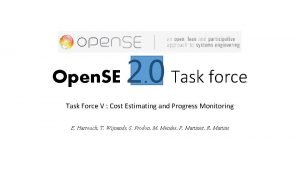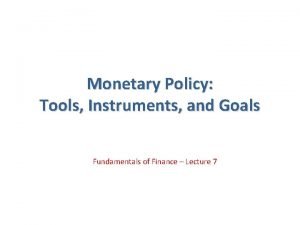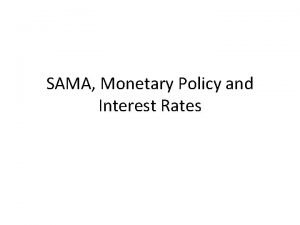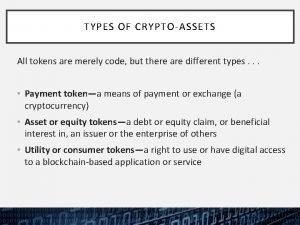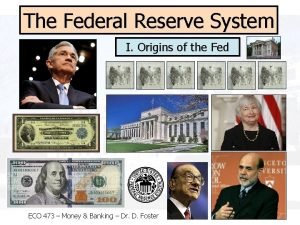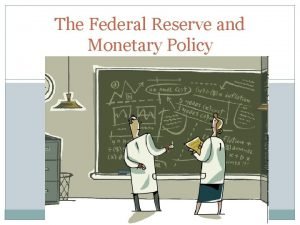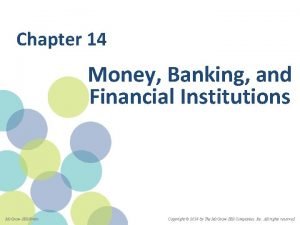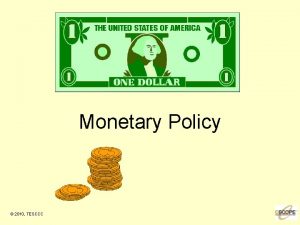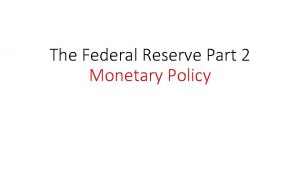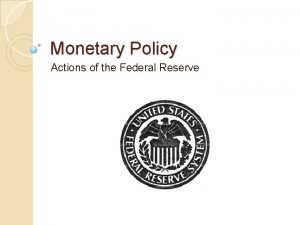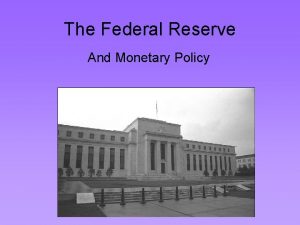Monetary Policy Tools Monetary Policy Federal Reserve Act









- Slides: 9

Monetary Policy Tools

Monetary Policy • Federal Reserve Act of 1913 created the Federal Reserve System – “The Fed” provides the U. S. banking system with the stabilizing influence of a central bank – 1977 amendment: to “promote effectively the goals of maximum employment, stable prices, and moderate longterm interest rates” • The Fed conducts monetary policy – Creates quantity of money that responds to the demands of the economy – Changing short-term interest rates and quantity of money [Note: we will not have a discussion of institutional aspects of money. ]

The Fed • Congress established as an independent organization • Income from investments and banking services • Three components: – The Board of Governors • sets overall direction of the Fed and its policies • 7 members appointed to 14 year terms by the president with the advise and consent of the Senate – The Federal Open Market Committee (FOMC) • conducts monetary policy • 12 members, 7 members from the Board plus 4 rotating district bank presidents and the president of the NY District Bank – The Federal Reserve Banks • regulates and provide a variety of services for banks • 12 regional banks

Open Market Operations • Primary tool to manage money supply – Currency—dollar bills and coins issued by the Federal Reserve System and the Treasury – Deposits at commercial banks and other depository institutions • Buy and sell government securities (Treasury bonds and bills) to commercial banks and general public • Does not issue government securities, can obtain in the open market • Open market operations put currency, Federal Reserve notes, into or out of circulation • Example: When you buy a bond from the Fed for $10, 000, you write a check and take money out of the economy

Reserve Ratio • Used infrequently • Banks hold some fraction of deposits on reserve to meet customers’ cash needs • Banks must meet the Fed’s reserve requirements – Current reserve requirement: about 10% – Banks hold at least $10 for every $100 of deposits • Alter reserve requirement, change money supply – Decrease required reserves increases money in circulation – Increase required reserves decreases money in circulation • some banks sell securities or call in loans • disruptive to customers

Discount Rate • Discount Rate: interest rate at which the Fed loans money to banks • Many short term interest rates tied to it • Discount rate changes move money supply in opposite direction – Increases in discount rate decrease money supply by decreasing borrowing (interest rates rise) – Decreases in discount rate increase money supply by increasing borrowing (interest rates fall) • Changes in discount rates foreshadow the Fed’s policy intentions

Expansionary Monetary Policy • Increase money supply when economy “too slow” – Buy securities (open market operations) – Reduce reserve ratios (not likely) – Lower the discount rate • Works through interest rates (price of money) – Money supply increases, more money so price of borrowing (interest) falls – Discount rate decreases, banks borrow more money and money supply increases (interest rates tied to it fall) • Interest rates fall, spending increases – Plant and equipment (by firms) – New housing – Consumer durables (especially autos) • Increased spending stimulates production, which reduces unemployment and increases GDP, which increases income, which stimulates spending…

Contractionary Monetary Policy • Decrease money supply if economy “too fast” – Sell securities (open market operations) – Increase reserve ratio (not likely) – Raise discount rate • Contractionary monetary policy effective with rapidly increasing GDP and inflation • Decreases investment and slows economic expansion • If economy sluggish, recession will deepen • Cost-push inflation, tight (contractionary) policies have little impact on slowing inflation

Monetary Policy in Action • Many argue price stability is the Fed’s primary goal • If the economy tends toward full employment, monetary policy’s greatest impact is on price level • Tradeoffs can exist between unemployment and inflation – Unemployed means not enough money to spend and the Fed can stimulate spending through expansionary policies – But too much money chasing too few goods increases prices (inflation) • Excessive growth in money supply a root cause of inflation – Friedman argued that given long term impacts of fluctuations in money supply, best is constant increase – 3% per year “the rule”
 Source of capital reserve
Source of capital reserve Contingency reserve vs management reserve
Contingency reserve vs management reserve Difference between capital reserve and reserve capital
Difference between capital reserve and reserve capital Three tools of monetary policy
Three tools of monetary policy Tools of monetary policy ppt
Tools of monetary policy ppt Federal reserve jurisdiction
Federal reserve jurisdiction Who created the federal reserve
Who created the federal reserve Structure of the federal reserve
Structure of the federal reserve Banking panics
Banking panics Federal reserve dual mandate
Federal reserve dual mandate

